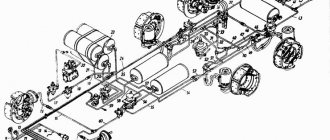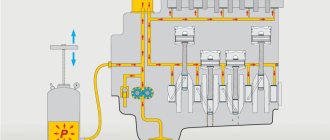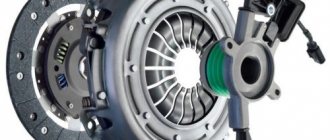Types of DRL
- Standard mercury arc fluorescent - characterized by weak color rendering, and during the glow a large amount of heat is released. It takes about five minutes from the moment it is plugged into the network to reach operating mode. They are extremely unstable to voltage surges, so operation is permissible in circuits with a constant power source. Designs that use these lamps must have heat-resistant wires.
- Arc mercury erythema tungsten (DRVED) is a lamp that operates without a choke. Connects via active ballast in the same way as standard incandescent light bulbs. Due to the presence of metal iodides, light transmission increases and energy consumption decreases. For greater brightness, uviol glass is used. Best suited for rooms with little natural light.
- DRLF is an improved DRL used to accelerate plant photosynthesis. The inside of the bulb is covered with reflective material, which is why the light bulb got its second name - reflector. Ideal for AC connection. It is used in greenhouses and greenhouses where an additional light source is required.
- Arc mercury tungsten - increased luminous efficiency, long service life without a ballast. An excellent option for lighting streets, parking lots, open areas, etc.
| Model | Rated voltage, V | Power, W | Length, mm | Diameter, mm | Base | Luminous flux, lm | Durability, h |
| DRL-125 | 125 | 125 | 177 | 77 | E27 | 6000 | 12 000 |
| DRL-250 | 130 | 250 | 227 | 90 | E40 | 13 500 | 15 000 |
| DRL-400 | 135 | 400 | 290 | 121 | E40 | 25 000 | 18 000 |
| DRL-700 | 140 | 700 | 356 | 151 | E40 | 40 000 | 20 000 |
| DRL-1000 | 145 | 1000 | 412 | 168 | E40 | 60 000 | 18 000 |
Expert opinion
Viktor Pavlovich Strebizh, lighting and electrical expert
Any questions ask me, I will help!
The inductor, connected to the power circuit together with the starter, generates a high voltage pulse to start the discharge between the electrodes. If there is something you don’t understand, write to me!
Alternative lighting sources
An energy-saving LED lamp is an excellent analogue to other lighting sources, including DRL; if you buy it, you can significantly save on electricity. Replacing street lighting will pay for itself after three years of operation, even taking into account the refurbishment work.
Many well-known foreign and Russian companies (for example, Lisma) are engaged in the production of these lighting devices. Currently, the price of these devices is slightly higher than the cost of a DRL lamp, but in the near future this problem will be eliminated, which will make LED lighting sources more accessible in Moscow, St. Petersburg, as well as in cities such as Saransk or Yekaterinburg.
DRL and DVR lamps are a common type of gas-discharge mercury lamps. They are used for street and indoor lighting. Both types are almost identical in appearance, especially when turned off. These are very efficient light sources in terms of energy saving, with a luminescence rate of 30 lm/W. This is quite a lot, but more modern varieties of light bulbs can have an output of 50 lm/W. Such lighting equipment is produced by many world-famous brands. It should be noted that due to the mercury content in lamps, they are prohibited in many countries, so the number of DRLs and DVRs is gradually decreasing.
How do DRL and DRV lamps work?
A quick glance at these lighting devices reveals some similarities with ordinary incandescent lamps with an E27 base. However, HID lamps have white tinted glass, with a transparent area just in front of the base. It is precisely because of the opacity that it is impossible to see that such devices have a specific structure inside.
Design and principle of combustion of DRL lamps
DRL (Arc Mercury Phosphor) lamp. Its design provides:
1 - Threaded base 2 - Resistor 3 - Molybdenum foil 4 - Ignitor (auxiliary) 5 - Supporting frame 6 - Outer bulb 7 - Compressed junction 8 - Mercury quartz arc discharge lamp 9 - Nitrogen filler 10 - Tungsten electrode (main) 11 - Lead wire
The base has a standard design, like the vast majority of household light bulbs used in chandeliers and lanterns. It receives electricity transmitted to its surface. It has two reception points. One electrode is located in the center, and the side of the base serves as the second electrode. The base is threaded into the lamp socket.
The main working element of the lamp is a quartz burner. On its sides there is a pair of electrodes. One is main and the other is auxiliary. They are located in an internal quartz flask filled with argon and mercury vapor.
The glass flask is placed on top of the quartz flask. To fill the space, nitrogen gas is pumped into it. The inside of the flask is painted with a white phosphor, so it is not transparent.
The operating principle of such lamps is more complex than that of incandescent lamps. When electricity is supplied to nearby electrodes, a glow discharge is created. This causes a breakdown of energy between them. As a result, the glow discharge develops into an arc discharge. It creates blue or violet radiation in the lamp. It provokes a bright glow of the phosphor, which colors the inside of the glass bulb. The phosphor itself produces a reddish light. As a result of mixing shades of red, blue, violet, a bright, almost white color is created.
Current fluctuations greatly affect the efficiency of the DRL glow. Even with electrical voltage surges of up to 15%, brightness drops can be as much as 30%. If the voltage drops to 80%, the lamp will go out.
The big disadvantage of such light bulbs is their strong heating. As a result, the insulation on the wire may burn out. Therefore, when connecting, you need to use only specialized heat-resistant cartridges and cable. In the light bulb itself, the pressure increases greatly during operation. In this regard, after turning it off, you need to wait until the flask has completely cooled down. If you turn on a hot light bulb again, it simply won’t light up.
The use of a DRL lamp implies the mandatory use of ballasts. A throttle is usually used as it. It limits the current that is supplied to power the lamp. The throttle matches the light fixture's power and directs the optimal amount of energy to it to minimize overheating and prevent uncomfortable lighting. If you do not use a ballast when turning on the lamp, the lamp will fail almost instantly.
Creating a homemade choke for a DRL 250 lamp
- a glass bulb is something that almost all light sources have. Used to protect internal parts;
- metal base - used for screwing into the lampshade of an electrical appliance;
- a tube filled with mercury vapor. It is placed inside a glass flask and is made of quartz glass. Usually mercury is diluted with argon;
- lamps can be equipped with secondary electrodes and cathodes. This speeds up the ignition of the product, reaching the operating mode and increases stability;
- A carbon resistor is needed to connect the electrodes and cathodes.
High Pressure Arc Lamps
Increasing the pressure of the medium in which the electric charge propagates and a luminous arc occurs makes it possible to obtain a more intense luminous flux, spending less energy. For example: the light output of low-pressure sodium lamps does not exceed 100 lumens per watt, while for high-pressure sodium lamps this value is more than 200 lumens per watt. Therefore, they are used for outdoor lighting or in large areas - greenhouses, hangars, production workshops.
The fundamental design of mercury and high-pressure sodium arc lamps has many similarities, but there are also differences, due to which the connection diagram of a sodium lamp is different from that of a mercury lamp. And they are not interchangeable. These lighting devices can be distinguished from each other both by designation and appearance. DRL – mercury arc lamp, DNaT – sodium arc tube lamp. And the external differences will become clear to you from analyzing their structure. So, they consist of the following elements:
- Gas burner.
- Set of electrodes.
- External flask.
- Base.
Gas-burner
In both cases, it is made in the form of a tube made of heat-resistant quartz glass. But in DRL its dimensions are larger than in DNAT. Due to the high chemical activity of sodium, aluminum alum – Al2O3 – is added to the burner glass. An inert gas - argon - is pumped into the burner at a pressure of 100-150 kPa. There is also mercury or sodium amalgam (an alloy of Na and Hg).
Electrode set
DRL lamps have four of them: two main and two ignition. The pairs are located at opposite ends of the flask and connected to different poles of the supply line. But DNAT has only two electrodes. This causes differences in the starting method and the construction of the lamp connection diagram.
With mercury light sources, the arc lights up from a small spark that occurs between electrodes of opposite sign. And sodium requires an igniting impulse. Moreover, the DRL of the first releases (until the mid-60s of the last century) had two electrodes and used the same switching principle, but later it was abandoned.
External flask
This is the main visual distinguishing feature of lamps. There is a vacuum inside the flask, which ensures the chemical and thermal stability of the burner glass. But with DRL it is white or matte, and the HPS flask is transparent.
A layer of phosphor is applied to the inner surface of the mercury lamp bulb. The fact is that the combustion of mercury vapor causes a deathly green or blue glow, which extremely distorts the perception of reality by the human eye. The phosphor shifts its spectrum into the region of dazzling white light, which is quite acceptable for street lighting.
Sodium lamps glow red or bright orange. Light rays of this frequency are practically not refracted by water suspension that can hang in the air (snow, fog, drizzle, splashes), so it is used to illuminate highways. There is no need for a spectral shift, so the bulb is transparent.
Base
Both lamps use a so-called Edison threaded base, designated by the letter E, to connect to the supply line. Since the power of high-pressure arc lamps usually exceeds 250 W, E40 models with a diameter of 400 mm are used. For the same reason, it is recommended to use ceramic cartridges that can withstand high heat.
What a non-standard connection option can achieve
Changing the usual method of connecting electrical components in fluorescent lamps is carried out in order to minimize the risk of device failure. Fluorescent lamps, despite having impressive advantages, such as excellent luminous flux and low energy consumption, also have some disadvantages. These should include:
- during their operation they produce a certain noise (hum), which is due to the functioning of the ballast element;
- high risk of starter burnout;
- possibility of filament overheating.
The above diagram for connecting the components of the electrical circuit will avoid all these disadvantages. When using it you will receive:
- the device will operate silently;
- there is no starter, which burns out more often than other parts when the lighting system is used frequently;
- It becomes possible to use a lamp with a burnt-out filament.
Here the role of a choke will be performed by a regular incandescent light bulb. Therefore, in such a situation there is no need to use expensive and rather bulky ballast.
Advantages and disadvantages
Among the advantages of the products, we note the following:
- Sufficient light output at a low cost.
- Independence from the presence of precipitation.
- Long service life - from 20,000 hours and above.
- Almost complete coincidence of the emission spectrum with natural light.
- Small dimensions.
The disadvantages, although minor, are much greater:
- Significant difference in price compared to higher quality varieties of DRL.
- During operation, ozone is formed.
- Lamps with tungsten filaments are much cheaper and more compact.
- Over time, the phosphor becomes obsolete, which leads to a deterioration in the emitted spectrum.
- Due to the use of mercury, special disposal is required.
- Delay when turning on.
- It takes several minutes to reach the nominal mode.
- Low quality of emitted light.
- Additional flickering during operation.
- It is recommended to install on the ceiling at a height of at least 4 m.
- They operate exclusively on alternating current.
Lighting devices based on mercury arc fluorescent lamps are one of the most economical solutions for lighting industrial facilities, open areas (parking lots), warehouses and the courtyard of a country house. Some models of pole lanterns combine high power and decorative appearance.
The mercury arc lamp (MAL) has another name - arc mercury phosphor. They belong to the category of high-pressure lamps and are used mainly as general lighting for areas with large volumes: streets, playgrounds, industrial premises, etc. The DRL lamp design allows for high light output. Power ranges from 50 to 2000 watts, they operate at alternating current, voltage 220 volts and frequency 50 hertz.
In order to coordinate the technical characteristics with the power source, ballasts are used in all types of mercury lamps, which allow the DRL lamp to be connected correctly. Most lighting devices are started by a choke, which is connected in series with the light bulb.
Types of DRL lamps
DRL lamps have several modifications that have different technical characteristics and operating conditions.
- Classic DRL lamp. Standard modification. The disadvantages of the model include high heating during operation, sensitivity to voltage changes, and a long time to reach optimal performance characteristics. The most common are DRL 250 lamp and DRL 400. The luminous flux of DRL 250 allows the device to be used in home lighting.
- DRV or DRVED – tungsten mercury arc (erythemal tungsten) lamp. The product starts without using a choke and has improved light emission performance.
- DRLF - unlike a standard lamp, it has improved characteristics due to the coating of the bulb with reflective material.
Expert opinion
Viktor Pavlovich Strebizh, lighting and electrical expert
Any questions ask me, I will help!
The versatility of the imported IZU lies in the fact that it can ignite any lamp, and works with any choke DNAT, MG, DRL. If there is something you don’t understand, write to me!
Checking functionality
To check the performance of the DRL, testers (ohmmeters) are used, which is necessary if the lamp refuses to work or functions incorrectly. Connect the device to each turn on the winding, checking them for open circuit and short circuit current:
- If a break is detected, the device will show a huge resistance, so you will have to replace the winding.
- If there is no break and no loss of insulation is detected (thus creating a short circuit), the difference in resistance will be less significant.
- If there is a short circuit on the inductor winding, an increase in resistance may not be observed and the technical characteristics will remain the same. On the other hand, this fact does not in any way affect the performance of the lamp itself.
If the ohmmeter does not show any deviations, then the problem should be looked for in the lighting fixture or electrical network. The lamp may need repairs.
Specifications
Any lighting product must have information about power. In DRL lamps it is indicated in the marking.
- Light flow. This value determines how many light bulbs are needed to create the required level of illumination per unit area. DRL 400 has a luminous flux of 18,000 lm.
- Approximate operating time. Shows how many hours the light bulb can work under the stated conditions.
- Base. Sets parameters for a chandelier or other lamp.
- Dimensions.
- Supply voltage.
All these parameters, as well as operating conditions, can be found in the documentation for the lamp.
Selection criteria: assessment of technical indicators
When determining the optimal lighting fixture, you should take into account the following characteristics:
- power;
- shape/size of the base;
- luminous flux brightness;
- duration of work.
Power. When choosing this option, you should focus on the purpose and location of the lamp. If a device is purchased to illuminate the road, then you need to take into account the distance between the lamps - the greater it is, the more efficient the lamps should be.
The range of power characteristics of DRL illuminators is in the range of 80-1000 W. This value is displayed in the lamp markings, for example, DRL 250, DRL 400, etc.
Light flow. The main indicator of light radiation directed in different directions. The parameter is measured in lumens (Lm). It is by this criterion, and not by power, that it is necessary to compare the performance of different types of lamps.
Lamps with a DRL lamp consume more electricity to produce the required luminous flux than their LED counterparts and DNAT illuminators. The brightness of an LED device of 100 W corresponds to the illumination indicator of its mercury-arc counterpart of 400 W
Significant savings on energy resources are a strong argument in favor of LEDs. The high cost of LED lamps pays off in the first year of operation.
Base. DRL illuminators are available with the two most popular types of bases:
- E27 – screw shape, diameter – 27 mm. Mercury-arc devices of 80 W and 125 W are equipped with this base.
- E40 is the largest size in the “E” category. The 40 mm base is used in lamps rated at 250 W and above, intended for lighting large areas.
In addition to the type of screwing into the socket, you should also take into account the dimensions of the lamp shade.
The width and length of the gas discharge lamp depends on the power of the device. The higher the performance of the DRL illuminator, the larger and heavier it is
Duration of service. This parameter is largely determined by the quality of workmanship, namely the responsibility of the manufacturer. It is better to choose lamps with a maximum service life. As a rule, high-power devices have a longer service life.
For clarity, the general characteristics of lamps of different powers are shown in the summary table. All electrical appliances operate on alternating current, the standard frequency is 50 Hz
Some information about the characteristics of lamps is included in the labeling. In domestic practice, the letter abbreviation denotes the name of the illuminator, and the digital abbreviation denotes power. The production of mercury lamps is regulated by GOST 27682-88 and GOST 53074-2008.
Foreign products of the DRL type are marked QE according to the international ILCOS system. Some manufacturers adhere to the pan-European ZVEI and German LBS designation order.
Markers for mercury lamps from popular companies:
- HPL – Philips;
- HRL – Radium;
- MBF – General Electric;
- HQL - Osram;
- HSL and HSB – Sylvania.
Additional designations according to ILCOS: QB – models with built-in ballast, QG – spherical bulb, QR – lamps with a reflective inner layer.
Connection diagram via inductor
In order for the DRL lamp to work properly, the correct connection diagram for this device is necessary. Thanks to proper installation, lighting such a llama will not be any problem, and it will always work efficiently and without failures.
In addition, an incorrect connection increases the risk that the device will deteriorate and burn out ahead of time or at all, when first turned on.
A chokeless connection is not possible, as the lamp will burn out immediately. To start, the circuit must be supplied with a fairly high voltage, which sometimes reaches a level equivalent to two or three incoming voltages.
As previously mentioned, the drl device does not light up immediately. In rare cases, complete warm-up and start of operation at full power may take fifteen minutes.
Expert opinion
Viktor Pavlovich Strebizh, lighting and electrical expert
Any questions ask me, I will help!
Here you can see that all the chokes are connected in parallel, that is, the chokes connected in parallel form one common ballast. If there is something you don’t understand, write to me!
Principle of operation
After connecting the electrical element to the network, voltage through the base is supplied to all electrodes, due to which a glow discharge is formed. Positive ions and free electrons appear inside the flask. After reaching a given level in the number of charges, an arc discharge is formed instead of a glow discharge. In most cases, all this takes no more than one minute.
It will take about five minutes for the DRL lamp to operate at its maximum light parameters. This is due to the time required for the evaporation of mercury drops placed in the gas-discharge chamber. This improves the brightness of the arc discharge.
The exact time to reach operating parameters is affected by the ambient temperature - the higher, the faster.
Operating principle and connection diagrams of DRL
The connection diagram for a two-electrode DRL is not discussed in the article, since this type of lamp is obsolete and is no longer produced.
What kind of lighting do you prefer?
Built-in Chandelier
When voltage is applied, gas ionization occurs between pairs of main and ignition electrodes. Since they are located in close proximity, ionization of the gas occurs easily between them. After ionization of the gas, a breakdown occurs between the main electrodes - an arc discharge is formed. The light from the discharge itself has a blue or violet tint.
The phosphor itself gives a reddish tint, thus mixing primary colors and producing cool white light. The visible shade may vary slightly depending on the applied voltage.
The choke is necessary, it is the simplest ballast - ballast. It also limits the current passing through the electrodes. If a DRL lamp is connected directly to the network, then its failure is inevitable. Usually this happens instantly. The polarity of the inductor connection does not play any role. Its main purpose is to stabilize the operation of the illuminator.
The selection of a choke for a specific DRL lamp is discussed in the table
You can study the design and operating principle of the throttle in detail here
The capacitor used is selected based on the power of the lamp. Recommendations are presented in the table.
With the current development of electronics, the choke is an archaic element. Electronic arc stabilization units can now be found on sale. These devices can withstand the precise power conditions required to start and maintain combustion, regardless of changes in voltage in the lighting network.
If you cannot purchase electronic ballast, you can make it yourself. Here Ф is phase, 0 is zero.
Design and principle of operation
A mercury gas discharge lamp, as its name suggests, is an electric light source that uses a gas discharge in mercury vapor to generate optical radiation. However, the adjective “luminescent” appears in the same name. This is due to the fact that to correct the color of the flux, the DRL lamp, in addition to the light from the gas discharge itself, uses the radiation of a phosphor that glows under its influence, which coats the inner surface of the lamp bulb. This makes the spectrum more uniform and wider and, as a result, improves color rendition.
It is known that for a discharge to occur in a gas, a high voltage must be applied between two electrodes, much greater than the standard 220 V. When a discharge already exists, it can be maintained at mains voltage. However, the smaller the distance between the electrodes, the less voltage is required to ignite the discharge. However, a small luminous area will not provide sufficient radiation power.
Therefore, in the first DRL lamps, the discharge was created using an external source of high voltage pulses, which pierced the working space between the electrodes when the lamp was turned on, and then the generator was turned off. Today, such a scheme has been returned to in sodium and metal halide gas-discharge lamps. However, at the time of the advent of mercury light sources (1960-70), such electronic devices were not reliable enough, so engineers had to look for another solution. Here we remembered the possibility of igniting a discharge using mains voltage at a small distance between the electrodes.
Since the 1970s, two additional ignition electrodes have been introduced into the design of mercury lamps, which are located very close to the main ones and are connected to opposite main electrodes through current-limiting resistors. Thus, when the lamp is turned on, two small glow discharges initially appear at each end of the burner, which gradually heat the entire volume of gas and ignite the main arc of the discharge (initially, this discharge is also glowing, but quickly turns into an arc). That is why the DRL’s paws do not immediately begin to glow brightly and for the first few minutes they “smolder” barely noticeably. In this case, the duration of the start-up mode strongly depends on the ambient temperature - the lower it is, the longer the lamp will warm up. A steady arc discharge between the main electrodes causes operating current to flow through the lamp, and small discharges no longer participate in the lamp combustion process.
Structurally, the burner with four electrodes is designed in the form of an internal flask made of quartz glass or special transparent ceramics, filled with an inert gas argon with the addition of metallic mercury. When the lamp is turned off and not warmed up, the mercury is inside the burner in the form of a separate small ball, or settles on the walls of the flask and electrodes in the form of a deposit. The material of the burner flask is very refractory and chemically resistant, so it can withstand the conditions necessary for a discharge to occur. The burner is placed inside an outer large flask made of ordinary glass. Conductors made of thick nickel wire and limiting resistances welded to them are also located here.
An electrical discharge in mercury vapor creates radiation with a very uneven, intermittent spectrum. It contains seven spectral lines, three of which, and at the same time the most intense, lie in the ultraviolet range. It is under their influence that the phosphor applied to the inner walls of the large flask glows. The visible light from the discharge has a blue-green hue, while the phosphor glows a warmer, reddish light. The radiation from both emitting objects, mixing, gives a bright and even light, quite close to white.
Requirements for disposal of mercury devices
You cannot thoughtlessly throw away used or defective mercury-containing light bulbs. Devices with a damaged bulb are a serious threat to human health and the environment as a whole, and therefore require specific disposal.
The question of the procedure for disposing of unsafe waste is relevant both for business owners and for ordinary residents. The processing of mercury lamps is carried out by organizations that have received the appropriate license.
The company enters into a service agreement with such a company. Upon request, a representative of the recycling company goes to the site, collects and removes the lamps for subsequent disinfection and recycling. The estimated cost of the service is 0.5 USD per lighting fixture.
Collection points have been set up to collect mercury-containing light bulbs from the population. People living in small towns can recycle hazardous waste through an “eco-mobile”
If the emission of mercury-containing lamps by enterprises is somehow controlled by regulatory authorities, then compliance with the rules of disposal by the population is the personal responsibility of citizens.
Unfortunately, due to low awareness, not every user of mercury lamps is aware of the possible consequences of mercury vapor entering the surrounding atmosphere.
All types of energy-saving lamps are described in detail in the following article, which discusses the principles of operation, compares the devices, and provides a simplified economic assessment.
| Name | Operating voltage, V | Power, W | Length, mm | Diameter, mm | Base type | Luminous flux, lm | Service life, hours |
| DRL 125 | 125 | 125 | 178 | 76 | E 27 | 5900 | 12000 |
| DRL 250 | 130 | 250 | 228 | 91 | E 40 | 13500 | 15000 |
| DRL 400 | 135 | 400 | 292 | 122 | E 40 | 24000 | 18000 |
| DRL 700 | 140 | 700 | 357 | 152 | E 40 | 41000 | 20000 |
| DRL 1000 | 145 | 1000 | 411 | 167 | E 40 | 59000 | 18000 |
Expert opinion
Viktor Pavlovich Strebizh, lighting and electrical expert
Any questions ask me, I will help!
This happens because when the starter contacts open, a self-induction EMF pulse of up to 1 kV is formed at the inductor terminals. If there is something you don’t understand, write to me!
Disposal
The lighting devices in question are classified as hazard class 1. Therefore, the number of places where these are prohibited for use is now growing. It is possible that in a few years mercury lamps will be phased out everywhere, as government policies are aimed at reducing the amount of equipment containing mercury. In compliance with government orders, utilities are reducing their use of DRLs.
Unfortunately, not everyone thinks about the issues of decommissioning such light sources. By doing this, they harm not only themselves, but also those around them.
Soon their sale will be completely stopped. Devices containing mercury will be left only in medical equipment until a safe analogue is found.
Currently, recycling of mercury lamps is a licensed service. On September 3, 2010, a corresponding decree of the Russian government was adopted. The document describes the requirements for the disposal process and contains information on the procedure for dealing with mercury contamination. The process of demercurization - removal of mercury is described.
Now all legal entities of the Russian Federation are required to create a waste passport for fluorescent lamps and keep strict records of mercury-containing waste. The presence of mercury is already a potential danger.
Recycling and recycling refers to the recovery of used metals from devices containing them. Including mercury. A damaged flask will allow liquid metal to escape into the environment.
In Russia, the Federal Law No. 187 is in force (Article 139). According to it, a fine will be collected for improper disposal or placement of a hazardous waste container in an inappropriate place. Unauthorized removal from the storage area is also punishable.
DRL lamp connection diagram: through or without a choke
- Formation of ozone during operation.
- Quite a high price (such lamps are 5–7 times more expensive than a regular incandescent lamp).
- In some cases, tungsten analogues will have smaller dimensions than DRL.
- After several months of operation, the emitted light spectrum changes as the technical characteristics of the phosphor layer change.
- The presence of mercury forces users to dispose of lamps according to a special scheme, separately from other goods, things, and products.
- Switching on occurs with some delay, and it takes several minutes to achieve combustion at full power.
- The light from such lamps is of rather low quality.
- Very high flicker factor during operation.
- It is best to hang lamps at a height of at least four meters.
- Towards the end of its service life, the luminous flux of the device decreases significantly.
- The lamp can only operate on alternating current.
Warm-up time
DRL 250 lamps begin to burn as much as possible (the characteristics of the devices will be indicated below) approximately 7-10 minutes after they are put into operation. It takes so much time because mercury in an unheated state, located in a quartz burner, is presented in the form of droplets or a thin layer on the walls of the glass flask. But after turning on the lamp, high temperature begins to act on this liquid metal, and this in turn leads to the evaporation of mercury and a gradual improvement in the discharge between the existing electrodes. At the moment when all the mercury is completely converted into gaseous form, the DRL lamp will begin to operate in its nominal mode.
Connection diagrams
Connection diagram via inductor
The function of the choke is to reduce the current required to operate the light source. In the absence of a choke, the lamp burns out due to high voltage. The elements are connected in series.
Connection diagram without choke
There is a separate technology used to connect DRL without a choke. The ideal option would be to purchase a factory DRL, which does not require a choke. The product is supplemented with a spiral that works like a regular stabilizer and dilutes the light flux.
Also, a regular incandescent light bulb, the power of which is comparable to DRL, can be connected to the circuit. It acts as a resistor that lowers the voltage at the output.
You can add one, two or more capacitors to the circuit. This is relevant if an important condition is met: the current that they will produce at the output must be calculated with high accuracy.
How to connect street lighting
If the lighting of streets, roads and parks is carried out by municipal services, then each owner arranges his own dacha or personal plot independently, based on his capabilities and preferences. DRL cantilever luminaires are the best option for the top tier of lighting; you can install one or more poles to completely cover the area.
You may also be interested in outdoor lamps for your home.
Floor lamps with balls will look good along alleys, above benches, above gates. Being located below, relative to the console ones, they form the second tier. One of the advantages of DRL lamps is their availability on the scale of a large area, with a large number of lighting points. The savings from their use are tangible. It will turn out to be both effective and decorative.
Although the energy consumption of DRL lamps is lower than that of incandescent lamps, if they burn all night long, bills to pay will contain a significant amount. To reduce costs, you should use presence sensors to turn on the lights. They can be equipped with lamps on the lower tier, since their light is required periodically.
Find more details about photo relays for street lighting here.
Connection
Unlike other lamps, gas-discharge mercury lamps are connected to the network through a ballast (ballast) - a choke. This is a stabilizer that converts the rated mains voltage into a starting voltage, which is more than 2 times higher. Without a throttle, the light will simply burn out when turned on. The circuit is a series connection of a lamp with a choke, connected to the network.
How can you start a DRL lamp without a choke?
It is possible to start a 250-watt arc lighting device without ballast, but for this it is necessary to use a different technology for turning on the device. Experts recommend the option of purchasing a special DRL 250 lamp, which has the ability to turn on without a ballast (choke), when a spiral is added to the lamp design, the task of which is to dilute the luminous flux.
Folk craftsmen also use a method of starting lamps of this type using a set of capacitors, but in this case you need to know exactly the amount of current received. Starting DRL lamps using a simple lamp is also used, but only on the condition that it has the same power as the DRL lamp.
DRL lamp: decoding, connection via inductor, LED analogues
DRL lamps are quite popular light sources. This is due to their positive qualities, which include:
Expert opinion
Viktor Pavlovich Strebizh, lighting and electrical expert
Any questions ask me, I will help!
Scheme for connecting a fluorescent lighting device through a ballast and a starter. Connecting lamps using a capacitor with a compensation function. If there is something you don’t understand, write to me!
Checking functionality
If, after connecting, your lamp does not want to work or does not work correctly, you should check it and test it to make sure it is working properly. To do this, a special tester or ohmmeter will help you.
With their help, it is necessary to check all turns of the winding for breaks or short circuits between adjacent turns. If the circuit has an open circuit, then the resistance will be infinitely large and the meter will show an abnormal value. In this case, it is necessary to completely replace the winding.
If there is no break, but there is a loss of insulation due to which a short circuit occurs, the resistance will increase slightly. If a small number of turns interact with each other, then the increase will be insignificant.
If the short circuit occurs in the inductor winding, then there will be virtually no increase in resistance and this will not affect the operation of the device in any way. After checking the entire winding with an ohmmeter or tester and finding no problems, you need to look for the problem in the light bulb itself or in the power supply system.
We start the lamp without a choke
If you want to use the drl 250 model as a normal device without using a standard choke, it can be connected using special technology.
The simplest connection option is to purchase a special drl 250, which can work without a throttle. It is equipped with a special spiral that acts as a stabilizer and further dilutes the emitted light.
One option not to use a choke is to connect a regular incandescent lamp to the circuit. It must have the same power as the DRL in order to produce the necessary resistance and supply voltage to the DRL 250 light source.
Another option to remove the inductor from the structure is to install a capacitor or group of capacitors. But in this case, it is necessary to accurately calculate the current they produce. It must fully comply with the required voltage for operation.
Application of the tester
One of the applications for using a multimeter is checking light bulbs. For this procedure, it is enough to use the simplest version of the device.
What information can be obtained using a multimeter? There are several indicators of the performance of light bulbs displayed on this device:
- suitability of the light bulb - violation of the integrity of the electrical connection leads to the cessation of current flow;
- determination of light bulb resistance;
- calculation of its power based on the resistance shown by the multimeter.
Thus, you can check the basic characteristics of the lighting device and understand whether it is suitable for further use.
Electronic ballast Electronic starting and control device (ballast)
All about ballasts
Electromagnetic ballasts for tubular fluorescent and compact fluorescent lamps for indoor use. Sometimes they are called: choke for fluorescent lamps. Electric shock protection class - I, environmental protection degree - IP 20.
LED lightening
LED lamps have been developed for a long time, but only recently a number of the latest diodes began to distribute as efficiently as possible the exact spectrum of light that plants need so much.
Which phytolight to choose?
We will help you decide! What would you like? Plant a whole vegetable garden in your apartment - low-growing tomatoes, sweet and hot peppers, cucumbers, many medicinal herbs, parsley, dill, cilantro, lettuce and even strawberries! Or just add more light to the seedlings?
Greenhouse lighting 7x42m with EasyGrow LED lamps.
has been introducing LED lighting for plants since 2011. Our accumulated experience allows us to offer high-quality and proven solutions for any area of crop production.
Phytolights for growing seedlings
Lighting seedlings is the most important condition for the effective cultivation of young plants. In this matter, it is important to choose the right lamps for illuminating plants, which is quite realistic given the fairly wide range.
Promhydroponics © 2010 — 2022 Copying site materials is permitted only if an active link to the source is indicated.
Internet department working hours: 8:00 - 17:00 Moscow time from Monday to Friday
Retail store opening hours: 10:00 - 20:00 Ekaterinburg time, seven days a week
Expert opinion
Viktor Pavlovich Strebizh, lighting and electrical expert
Any questions ask me, I will help!
Folk craftsmen also use a method of starting lamps of this type using a set of capacitors, but in this case you need to know exactly the amount of current received. If there is something you don’t understand, write to me!
Ultraviolet - we get it at home quickly and for pennies.
Nowadays, chemistry based on photocatalysts is becoming widespread.
A variety of adhesives, varnishes, photosensitive emulsions and other interesting achievements of the chemical industry. Unfortunately, industrial UV installations cost a lot of money. What should you do if you just want to try chemistry? will it fit or not? For this purpose, buying branded devices for N kilobucks is too expensive...
In the territory of the former USSR, the situation is usually solved by extracting quartz tubes from DRL-type lamas; there is a whole line of lamas from DRL-125 to DRL-1000, with the help of them you can obtain fairly powerful radiation, this radiation is usually enough for most occasional tasks. Like hardening the glue or varnish once a month, or exposing the photorhizist.
A lot of information has been written on how to extract a tube from DRL lamps, how to do it safely. I would like to touch on another aspect, namely the launch of these lamps with minimal financial costs.
Standardly, a special choke with increased magnetic dispersion is used for starting. But even this is not always available, and because... It’s heavy, so usually delivery to the regions costs a pretty penny. 700W throttle + delivery costs $100. What to try as an option, too, it’s never cheap.
The main problem with starting mercury lamps is the presence of an arc discharge. Moreover, a cold lamp and a hot lamp have fundamentally different resistance to the burning arc. Approximately from units of ohms to tens of ohms. Accordingly, this is what the inductor serves for, which limits the current during startup and operation of the lamp. It must be admitted that the choke is a rather archaic tool, and for expensive and powerful lamps used in UF dryers (several kilowatts of power, and several thousand dollars per lamp), electronic arc stabilization units are used. These blocks allow you to more accurately maintain arc burning parameters, thereby extending the life of the lamp and reducing problems during curing. Even for an archaic DRL, the manufacturer writes that the voltage spread is no more than 3%, otherwise the service life will be reduced.
How to start a DRL lamp without a choke using improvised means?
The answer is simple, you just need to limit the current in all operating modes, starting with warming up and ending with operating mode. We will limit it with a resistor.
But since the resistor must be very powerful, we will use the heating devices available at hand (incandescent lamps, irons, kettles, water heaters, hand boilers, etc.) It sounds funny, but it will work and fulfill its purpose.
The only drawback is the excessive consumption of electricity, i.e. if we run a 400W DRL lamp on the ballast, about 250W will be released into heat. But I think for the task of trying ultraviolet light, or for occasional work it is not important.
Why didn't anyone do this?
Why no one, there are DRB lamps that use exactly this principle. Next to the quartz tube is the filament of a regular light bulb.
And the writers on the Internet apparently didn’t study physics at school. Well, of course, one more small nuance, you need a heating circuit, i.e. We heat the lamp with one resistor and switch it to operating mode with the other. But I think many people can cope with a switch and two wires











